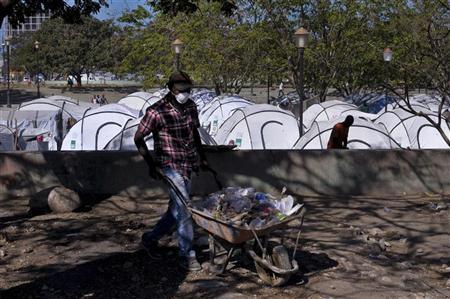 PORT-AU-PRINCE (Reuters) – Haitians marked the second anniversary on Thursday of a devastating earthquake that ravaged their impoverished Caribbean country, as their president held out new promises to rebuild the shattered land.
PORT-AU-PRINCE (Reuters) – Haitians marked the second anniversary on Thursday of a devastating earthquake that ravaged their impoverished Caribbean country, as their president held out new promises to rebuild the shattered land.
Many women donned white dresses as they observed a national day of mourning by attending church services across the deeply religious country.
They also held solemn ceremonies at mass grave sites to remember the dead from one of the world’s worst-ever natural disasters.
The 7.0 magnitude quake on January 12, 2010, lasted only 10 to 20 seconds but toppled buildings and homes like cards and killed roughly 300,000 people and left more than 1.5 million homeless.
President Michel Martelly has vowed to redouble government efforts to help people rebuild their lives and reverse a painfully slow recovery marked by squalid tent camps that are home to more than a half a million people in the Haitian capital, Port-au-Prince.
“This year is a year when we will really start rebuilding physically but also rebuilding the hope and the future of the Haitian people,” the shaven-headed former Carnival music star known as “Sweet Micky” said on Wednesday.
Martelly, a political novice who took office last year, also announced new efforts backed by the Canadian government to relocate some 20,000 people from tent encampments only blocks from the still-crumpled presidential palace.
Canada said it was contributing million to the relocation effort.
WREATH-LAYING CEREMONY
In one of the main events at Thursday’s remembrance, Martelly and former U.S. President Bill Clinton, who has promoted job creation as key to efforts to lift Haiti out of decades of misery and corruption, were to lay wreaths at a mass burial ground on the outskirts of Port-au-Prince.
Despite billions of dollars of international donations and aid pledges, many Haitians say they see few tangible results of the recovery and reconstruction effort.
Just over half of the piles of concrete, steel and other debris littering Port-au-Prince and its surrounding areas has been cleared.
Haitians also complain about a lack of housing and jobs two years after the quake.
“My hope is we will do everything we can to honor the memory of those who died by transforming the disaster into an opportunity to provide a better future for Haitians,” said Junot Mura, a 23-year-old Port-au-Prince resident who said the quake took the life of his father.
Government officials point to post-quake projects like a 7 million industrial park being built on Haiti’s northwest coast and a program to stimulate agriculture production as evidence some progress is being made.
But for some Haitians, at least, promises of a better future ring hollow after two years of seemingly glacial reconstruction efforts in the poorest country in the Americas.
“I stopped living after the quake,” said Dieuline Mesidor, a 39-year-old mother who spoke outside the damaged Sacre-Coeur church in the capital.
She said she lost two children, a son and a daughter, in the earthquake.
“I’ve lost all interest in life,” she said.
(Addiitional reporting by Swoan Parker; Editing by Tom Brown and Philip Barbara)



